
SPECIFICATIONS
Voltage: 18V
No Load Speed: 8500/min
Disc Diameter: 115mm (4
1/2
”)
Spindle: M14
Weight: 1.8kg
CORDLESS
ANGLE GRINDER
INSTRUCTION MANUAL
ozito.com.au
PXAGS-500
Power tools that are no longer usable should not be disposed of with
household waste but in an environmentally friendly way. Please recycle
where facilities exist. Check with your local council authority for
recycling advice.
Recycling packaging reduces the need for landll and raw materials.
Reuse of recycled material decreases pollution in the environment.
Please recycle packaging where facilities exist. Check with your local
council authority for recycling advice.
WHAT’S IN THE BOX
Angle Grinder
Side Handle
Safety Guard
Pin Wrech
Grinding Disc
DESCRIPTION OF SYMBOLS
CARING FOR THE ENVIRONMENT
BATTERY & CHARGER SAFETY WARNINGS
TROUBLESHOOTING
Spare parts can be ordered from the Special Orders
Desk at your local Bunnings Warehouse.
For further information, or any parts not listed here,
visit www.ozito.com.au or contact Ozito Customer
Service:
Australia 1800 069 486
New Zealand 0508 069 486
SPARE PARTS
WARNING! When using mains-powered tools, basic safety precautions, including the
following, should always be followed to reduce risk of fire, electric shock, personal injury
and material damage.
Read the whole manual carefully and make sure you know how to switch the tool off in an emergency, before operating the tool.
Save these instructions and other documents supplied with this tool for future reference.
The charger has been designed for 230V and 240V only. Always check that the power supply corresponds to the voltage on the rating
plate.
Note: The supply of 230V and 240V on Ozito tools are interchangeable for Australia and New Zealand.
This tools charger is double insulated therefore no earth wire is required.
If the supply cord is damaged, it must be replaced by an electrician or a power tool repairer in order to avoid a hazard.
Note: Double insulation does not take the place of normal safety precautions when operating this tool. The insulation system is for
added protection against injury resulting from a possible electrical insulation failure within the tool.
The power supply for this products charger should be protected by a residual current device (rated at 30mA or less). A residual current
device reduces the risk of electric shock.
GENERAL POWER TOOL SAFETY WARNINGS
ELECTRICAL SAFETY
THIS MANUAL CONTAINS IMPORTANT SAFETY AND OPERATING INSTRUCTIONS FOR
YOUR BATTERY CHARGER.
1. Before using the charger read all instructions and cautionary markings on the charger, battery pack
and the product using the battery pack.
2. This charger is not intended for any uses other than charging rechargeable batteries. Any other use
may result in risk of re, electric shock or electrocution.
3. Do not place any object on top of the charger or place the charger on a soft surface that may result
in excessive internal heat. Place the charger in a position away from any heat source.
4. To reduce risk of damage to the electric plug and cord, pull by the plug rather than the cord when
disconnecting the charger.
5. Make sure the cord is located so that it will not be stepped on, tripped over, or otherwise subjected
to damage or stress.
6. An extension cord should not be used unless absolutely necessary. Use of an improper extension cord
could result in the risk of re, electric shock or electrocution.
7. Do not operate the charger if it has received a sharp blow, been dropped or otherwise damaged in
any way. Have it checked by an electrician or power tool repairer.
8. Do not disassemble charger. Take it to an electrician or power tool repairer when service or repair is
required. Incorrect reassembly may result in a risk of electric shock, electrocution or re.
9. To reduce risk of electric shock, unplug the charger from the outlet before attempting any cleaning.
Removing the battery pack will not reduce this risk.
10. Never attempt to connect 2 chargers together.
11. DO NOT store or use the tool and battery pack in locations where the temperature may reach or exceed
40ºC (such as inside sheds or metal buildings in summer).
12. The charger is designed to operate on standard household electrical power (240 volts). Do not
attempt to use it on any other voltage!
13. The battery pack is not fully charged out of the carton. First read the safety instructions and then
follow the charging notes and procedures.
14. The longest life and best performance can be obtained if the battery pack is charged when the air
temperature is between 18 - 24ºC. Do not charge the battery pack in an air temperature below 10ºC
or above 40ºC. This is important and will prevent damage to the battery pack.
15. Do not incinerate the battery pack even if it is seriously damaged or is completely worn out. The battery
can explode in a re.
16. Never attempt to open the battery pack for any reason. If the plastic housing of the battery pack breaks or
cracks, immediately discontinue use and do not recharge.
17. During charging, the battery must be placed in a well ventilated area.
WARNING! Read all safety warnings and all instructions. Failure to follow the warnings and
instructions may result in electric shock, re and/or serious injury.
Save all warnings and instructions for future reference. The term “power tool” in the
warnings refers to your mains-operated (corded) power tool or battery-operated (cordless) power
tool.
1. Work area safety
a. Keep work area clean and well lit. Cluttered or dark areas invite accidents.
b. Do not operate power tools in explosive atmospheres, such as in the presence of flammable
liquids, gases or dust. Power tools create sparks which may ignite the dust or fumes.
c. Keep children and bystanders away while operating a power tool. Distractions can cause you to lose
control.
2. Electrical safety
a. Power tool plugs must match the outlet. Never modify the plug in any way. Do not use any
adapter plugs with earthed (grounded) power tools. Unmodied plugs and matching outlets will reduce risk
of electric shock.
b. Avoid body contact with earthed or grounded surfaces, such as pipes, radiators, ranges and
refrigerators. There is an increased risk of electric shock if your body is earthed or grounded.
c. Do not expose power tools to rain or wet conditions. Water entering a power tool will increase the risk of
electric shock.
d. Do not abuse the cord. Never use the cord for carrying, pulling or unplugging the power tool.
Keep cord away from heat, oil, sharp edges or moving parts. Damaged or entangled cords increase the
risk of electric shock.
e. When operating a power tool outdoors, use an extension cord suitable for outdoor use. Use of
a cord suitable for outdoor use reduces the risk of electric shock.
f. If operating a power tool in a damp location is unavoidable, use a residual current device
(RCD) protected supply. Use of an RCD reduces the risk of electric shock.
3. Personal safety
a. Stay alert, watch what you are doing and use common sense when operating a power tool.
Do not use a power tool while you are tired or under the influence of drugs, alcohol or
medication. A moment of inattention while operating power tools may result in serious personal injury.
b. Use personal protective equipment. Always wear eye protection. Protective equipment such as dust
mask, non-skid safety shoes, hard hat, or hearing protection used for appropriate conditions will reduce personal injuries.
c. Prevent unintentional starting. Ensure the switch is in the off-position before connecting to
power source and/or battery pack, picking up or carrying the tool. Carrying power tools with your
nger on the switch or energising power tools that have the switch on invites accidents.
d. Remove any adjusting key or wrench before turning the power tool on. A wrench or a key left
attached to a rotating part of the power tool may result in personal injury.
e. Do not overreach. Keep proper footing and balance at all times. This enables better control of the
power tool in unexpected situations.
f. Dress properly. Do not wear loose clothing or jewellery. Keep your hair, clothing and gloves
away from moving parts. Loose clothes, jewellery or long hair can be caught in moving parts.
g. If devices are provided for the connection of dust extraction and collection facilities, ensure
these are connected and properly used. Use of dust collection can reduce dust-related hazards.
4. Power tool use and care
a. Do not force the power tool. Use the correct power tool for your application. The correct power
tool will do the job better and safer at the rate for which it was designed.
b. Do not use the power tool if the switch does not turn it on and off. Any power tool that cannot be
controlled with the switch is dangerous and must be repaired.
c. Disconnect the plug from the power source and/or the battery pack from the power tool
before making any adjustments, changing accessories, or storing power tools. Such preventive
safety measures reduce the risk of starting the power tool accidentally.
d. Store idle power tools out of the reach of children and do not allow persons unfamiliar with
the power tool or these instructions to operate the power tool. Power tools are dangerous in the hands
of untrained users.
e. Maintain power tools. Check for misalignment or binding of moving parts, breakage of parts
and any other condition that may affect the power tool’s operation. If damaged, have the
power tool repaired before use. Many accidents are caused by poorly maintained power tools.
f. Keep cutting tools sharp and clean. Properly maintained cutting tools with sharp cutting edges are less likely to
bind and are easier to control.
g. Use the power tool, accessories and tool bits etc. in accordance with these instructions,
taking into account the working conditions and the work to be performed. Use of the power tool for
operations different from those intended could result in a hazardous situation.
5. Battery tool use and care
a. Recharge only with the charger specified by the manufacturer. A charger that is suitable for one type of
battery pack may create a risk of re when used with another battery pack.
b. Use power tools only with specifically designated battery packs. Use of any other battery packs may
create a risk of injury and re.
c. When battery pack is not in use, keep it away from other metal objects, like paper clips,
coins, keys, nails, screws or other small metal objects, that can make a connection from one
terminal to another. Shorting the battery terminals together may cause burns or a re.
d. Under abusive conditions, liquid may be ejected from the battery; avoid contact. If contact
accidentally occurs, flush with water. If liquid contacts eyes, additionally seek medical help.
Liquid ejected from the battery may cause irritation or burns.
6. Service
a. Have your power tool serviced by a qualified repair person using only identical replacement
parts. This will ensure that the safety of the power tool is maintained.
Battery & Charger
sold separately
LED lights do not illuminate on charger
Check the charging adaptor is securely plugged into the wall out let.
Check the battery is rmly connected to the charging cradle.
Check that the charging jack is securely connected to the charging cradle.
The battery has a short run time
Ensure the battery is properly charged. It will take 4-5 charging cycles before the battery
reaches optimum charge and run time. On the initial charge, the battery requires 5 hours
of charging. Subsequent charging only requires 3-5 hours.
Sparking visible through the housing vents
A small amount of sparking may be visible through the housing vents.
This is normal and does not indicate a problem.
Spindle locking button will not depress
The spindle will need to be rotated until the lock can engage. Simply rotate the spindle
while applying a small amount of pressure on the spindle lock.
ANGLE GRINDER SAFETY WARNINGS
MAINTENANCE
• After each use, blow air through the tool housing to ensure it is free from all dust,
dirt, etc. Build up of dust, dirt particles may cause the tool to overheat and shorten
the life of the tool.
• If the housing of the angle grinder requires cleaning, do not use solvents but a moist
soft cloth or soft brush only.
• Never let any liquid get inside the tool, never immerse any part of the tool into liquid.
• When not in use, the angle grinder should be stored in a dry, frost free location not
within the reach of children.
WARNING! ALWAYS ENSURE THE TOOL HAS
COMPLETELY STOPPED AND THE BATTERY IS
REMOVED PRIOR TO ANY MAINTENANCE.
Note: Ozito Industries will not be responsible for any damage or injuries caused by
the repair of the angle grinder by an unauthorised person or by mishandling of the
angle grinder.
Warning
Read instruction manual
mA
n
0
Milliamperes
Ah Amp hour
No load speed
V Volts Hz Hertz
ac/~ Alternating current
Direct current
dc/
/min
Always wear ear, eye and
a safety mask
Revolutions or
reciprocation per minute
Always wear gloves
Wear eye protection
Regulatory Compliance
Mark (RCM)
WARNING! a) This power tool is intended to function as a grinder, sanding or cut-off
tool. Read all safety warnings, instructions, illustrations and specifications provided with
this power tool.
Failure to follow all instructions listed below may result in electric shock, fir and/or serious injury.
b) Operations such as wire brushing, or polishing are not recommended to be performed with this
power tool. Operations for which the power tool was not designed may create a hazard and cause personal injury.
c) Do not use accessories which are not specifically designed and recommended by the tool
manufacturer. Just because the accessory can be attached to your power tool, it does not assure safe operation.
d) The rated speed of the accessory must be at least equal to the maximum speed marked on the
power tool. Accessories running faster than their rated speed can break and y apart
e) The outside diameter and the thickness of your accessory must be within the capacity rating of
your power tool. Incorrectly sized accessories cannot be adequately guarded or controlled.
f) The arbour size of wheels, flanges, backing pads or any other accessory must properly fit the
spindle of the power tool. Accessories with arbour holes that do not match the mounting hardware of the power tool will run out
of balance, vibrate excessively and may cause loss of control.
g) Do not use a damaged accessory. Before each use inspect the accessory such as abrasive wheels for chips and cracks,
backing pad for cracks, tear or excess wear, wire brush for loose or cracked wires. If power tool or accessory is dropped, inspect for
damage or install an undamaged accessory. After inspecting and installing an accessory, position yourself and bystanders away from the
plane of the rotating accessory and run the power tool at maximum no-load speed for one minute. Damaged accessories will normally
break apart during this test time.
h) Wear personal protective equipment. Depending on application, use face shield, safety goggles or safety glasses. As
appropriate, wear dust mask, hearing protectors, gloves and workshop apron capable of stopping small abrasive or work piece fragments.
The eye protection must be capable of stopping ying debris generated by various operations . The dust mask or respirator must be
capable of ltrating particles generated by your operation. Prolonged exposure to high intensity noise may cause hearing loss.
i) Keep bystanders a safe distance away from work area. Anyone entering the work area must wear personal
protective equipment. Fragments away and cause injury beyond immediate area of operation.
j) Hold power tool by insulated gripping surfaces only, when performing an operation where the
cutting accessory may contact hidden wiring or its own cord. Cutting accessory contacting a “live” wire may make
exposed metal parts of the power tool “live” and shock the operator.
k) Never lay the power tool down until the accessory has come to a complete stop. The spinning accessory
may grab the surface and pull the power tool out of your control.
l) Do not run the power tool while carrying it at your side. Accidental contact with the spinning accessory could snag
your clothing, pulling the accessory into your body.
m) Regularly clean the power tool’s air vents. The motor’s fan will draw the dust inside the housing and excessive
accumulation of powdered metal may cause electrical hazards.
n) Do not operate the power tool near flammable materials. Sparks could ignite these materials.
o) Do not use accessories that require liquid coolants. Using water or other liquid coolants may result in electrocution or shock.
Kickback and related warnings
Kickback is a sudden reaction to a pinched or snagged rotating wheel, backing pad, brush or any other accessory. Pinching or snagging
causes rapid stalling of the rotating accessory which in turn causes the uncontrolled power tool to be forced in the direction opposite of
the accessory’s rotation at the point of the binding.
For example, if an abrasive wheel is snagged or pinched by the work piece, the edge of the wheel that is entering into the pinch point
can dig into the surface of the material causing the wheel to climb out or kick out. The wheel may either jump toward or away from
the operator, depending on direction of the wheel’s movement at the point of pinching. Abrasive wheels may also break under these
conditions. Kickback is the result of power tool misuse and/or incorrect operating procedures or conditions and can be avoided by taking
proper precautions as given below.
a)Maintain a firm grip on the power tool and position your body and arm to allow you to resist
kickback forces. Always use auxiliary handle, if provided, for maximum control over kickback or torque reaction during start-up. The
operator can control torque reactions or kickback forces, if proper precautions are taken.
b) Never place your hand near the rotating accessory. Accessory may kickback over your hand.
c) Do not position your body in the area where power tool will move if kickback occurs. Kickback will
propel the tool in direction opposite to the wheel’s movement at the point of snagging.
d) Use special care when working corners, sharp edges etc. Avoid bouncing and snagging the accessory. Corners,
sharp edges or bouncing have a tendency to snag the rotating accessory and cause loss of control or kickback.
e) Do not attach a saw chain woodcarving blade or toothed saw blade. Such blades create frequent kickback
and loss of control.
Additional safety instructions for grinding and abrasive cutting-off operations
a) Use only wheel types that are recommended for your power tool and the specific guard designed
for the selected wheel. Wheels for which the power tool was not designed cannot be adequately guarded and are unsafe.
b) The guard must be securely attached to the power tool and positioned for maximum safety, so
the least amount of wheel is exposed towards the operator. The guard helps to protect operator from broken wheel
fragments and accidental contact with wheel.
c) Wheels must be used only for recommended applications. For example: do not grind with the side of cut-off
wheel. Abrasive cut-off wheels are intended for peripheral grinding, side forces applied to these wheels may cause them to shatter.
d) Always use undamaged wheel flanges that are of correct size and shape for your selected wheel.
Proper wheel anges support the wheel thus reducing the possibility of wheel breakage. Flanges for cut-off wheels may be different from
grinding wheel anges.
e) Do not use worn down wheels from larger power tools. Wheel intended for larger power tool is not suitable for
the higher speed of a smaller tool and may burst.
Additional safety instructions for abrasive cutting-off operations:
a) Do not “jam” the cut-off wheel or apply excessive pressure. Do not attempt to make an excessive depth of
cut. Overstressing the wheel increases the loading and susceptibility to twisting or binding of the wheel in the cut and the possibility of
kickback or wheel breakage.
b) Do not position your body in line with and behind the rotating wheel. When the wheel, at the point of
operation, is moving away from your body, the possible kickback may propel the spinning wheel and the power tool directly at you.
c) When wheel is binding or when interrupting a cut for any reason, switch off the power tool and
hold the power tool motionless until the wheel comes to a complete stop. Never attempt to remove the cut-off
wheel from the cut while the wheel is in motion otherwise kickback may occur. Investigate and take corrective action to eliminate the
cause of wheel binding.
d) Do not restart the cutting operation in the work piece. Let the wheel reach full speed and carefully reenter the
cut. The wheel may bind, walk up or kickback if the power tool is restarted in the work piece.
e) Support panels or any oversized work piece to minimize the risk of wheel pinching and kickback.
Large work pieces tend to sag under their own weight. Supports must be placed under the work piece near the line of cut and near the
edge of the work piece on both sides of the wheel.
f) Use extra caution when making a “pocket cut” into existing walls or other blind areas. The protruding
wheel may cut gas or water pipes,electrical wiring or objects that can cause kickback.
Additional safety instructions for sanding operations
a) Do not use excessively oversized sanding disc paper. Follow manufacturers recommendations, when selecting
sanding paper. Larger sanding paper extending beyond the sanding pad presents a laceration hazard and may cause snagging, tearing of
the disc or kickback.
We highly recommend that when using abrasive cutting wheels, that a cutting guard should be
fitted to your angle grinder. These cutting guards are available as a spare part and can be ordered
through the special orders desk
Battery protection system
The tool is equipped with the battery protection system, which helps to ensure a long service
life.
The output power automatically cuts off during operation when the tool and/or battery are
placed under the following situations:
• When the tool is overloaded:
If this occurs, release the trigger switch and remove causes of overload, then pull the
switch trigger again to restart.
• When the remaining battery capacity becomes low:
Recharge the battery pack.
Note: The battery protection system does not in any way damage the tool.
Note: The indicated capacity may be lower than the actual level during use or immediately
after using the tool.
IN ORDER TO MAKE A CLAIM UNDER THIS WARRANTY YOU
MUST RETURN THE PRODUCT TO YOUR NEAREST BUNNINGS
WAREHOUSE WITH YOUR BUNNINGS REGISTER RECEIPT. PRIOR TO
RETURNING YOUR PRODUCT FOR WARRANTY PLEASE TELEPHONE
OUR CUSTOMER SERVICE HELPLINE:
Australia 1800 069 486
New Zealand 0508 069 486
WARRANTY
TO ENSURE A SPEEDY RESPONSE PLEASE HAVE THE MODEL
NUMBER AND DATE OF PURCHASE AVAILABLE. A CUSTOMER
SERVICE REPRESENTATIVE WILL TAKE YOUR CALL AND
ANSWER ANY QUESTIONS YOU MAY HAVE RELATING TO THE
WARRANTY POLICY OR PROCEDURE.
OZITO Australia/New Zealand (Head Ofce) 1-23 Letcon Drive, Bangholme, Victoria, Australia 3175.
The benets provided under this warranty are in addition to other rights and
remedies which are available to you at law.
Our goods come with guarantees that cannot be excluded at law. You are entitled to
a replacement or refund for a major failure and for compensation for any other
reasonably foreseeable loss or damage. You are also entitled to have the goods
repaired or replaced if the goods fail to be of acceptable quality and the failure
does not amount to a major failure.
Generally you will be responsible for all costs associated with a claim under this
warranty, however, where you have suffered any additional direct loss as a result of
a defective product you may be able to claim such expenses by contacting our
customer service helpline above.
0616
WARNING
The following actions will result in the warranty being
void.
• If the tool has been operated on a supply voltage other than that specied
on the tool.
• If the tool shows signs of damage or defects caused by or resulting from
abuse, accidents or alterations.
• Failure to perform maintenance as set out within the instruction manual.
• If the tool is disassembled or tampered with in any way.
5 YEAR REPLACEMENT WARRANTY
Your Product is guaranteed for a period of 60 months from the original date of
purchase and is intended for DIY (Do It Yourself) use only. If a product is defective it
will be replaced in accordance with the terms of this warranty. Lithium Ion
batteries and chargers are covered by a 36 month
warranty and are excluded from the warranty extension. Warranty excludes
consumable parts.


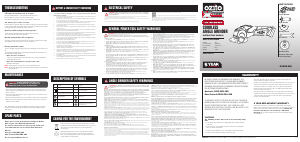

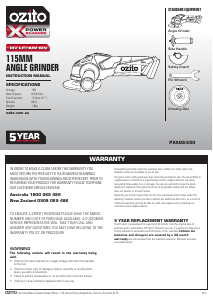
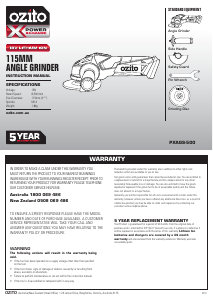
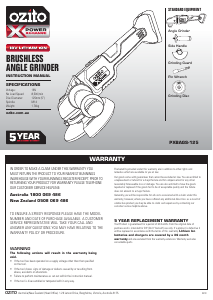
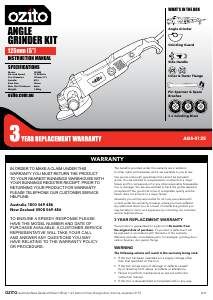
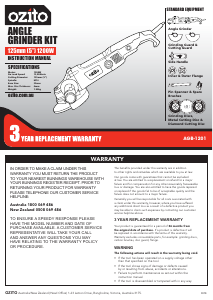
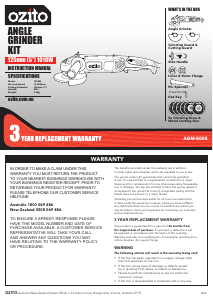
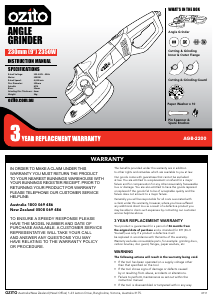
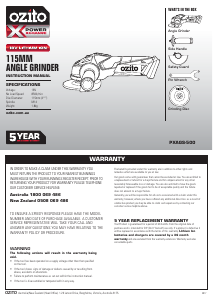
Join the conversation about this product
Here you can share what you think about the Ozito PXAGS-500 Angle Grinder. If you have a question, first carefully read the manual. Requesting a manual can be done by using our contact form.